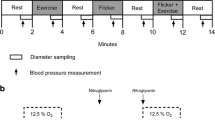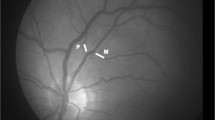Abstract
Purpose
Diabetic retinopathy is accompanied with changes in the diameter regulation and oxygenation of retinal vessels. Previous studies have shown that in normal persons and in diabetic patients without retinopathy hypoxia-induced vasodilatation is mediated by cyclo-oxygenase (COX) products and nitric oxide (NO). The purpose of the present study was to study whether these effects can be reproduced in patients with diabetic maculopathy.
Methods
Eighteen patients with diabetic maculopathy aged 29–57 years were examined using the Dynamic Vessel Analyzer. The resting diameter and the diameter changes of retinal arterioles during isometric exercise and flicker stimulation were studied before and during breathing a hypoxic gas mixture. The examinations were also performed before and during intravenous infusion of the NOS inhibitor L-NMMA, and were repeated on a second day after topical administration of the COX-inhibitor diclofenac.
Results
The diameter of retinal arterioles showed no significant change during hypoxia or L-NMMA infusion, or after topical application of diclofenac (p > 0.25 for all comparisons). The resting diameter of the venules was significantly increased during hypoxia (p = 0.003) and decreased during L-NMMA infusion (p < 0.0001). The diameter of retinal venules during isometric exercise increased significantly during hypoxia (p = 0.01). Flicker stimulation induced significant dilatation of the venules, which was significantly reduced during hypoxia and increased during L-NMMA infusion (p < 0.0001 for all comparisons).
Conclusion
Hypoxia-induced dilatation of retinal arterioles is severely reduced in patients with diabetic maculopathy. Future intervention studies aimed at normalizing the diameter regulation of retinal arterioles in diabetic patients should preferentially be conducted in the early stages of the disease where the potential for changing the vessel diameter is preserved.
ClinicalTrials.gov identifier: NCT01689090



Similar content being viewed by others
References
Ding J, Wong TY (2012) Current epidemiology of diabetic retinopathy and diabetic macular edema. Curr Diab Rep 12(4):346–354
Stitt AW, Lois N, Medina RJ, Adamson P, Curtis TM (2013) Advances in our understanding of diabetic retinopathy. Clin Sci (Lond) 125(1):1–17
Kristinsson JK, Gottfredsdottir MS, Stefansson E (1997) Retinal vessel dilatation and elongation precedes diabetic macular oedema. Br J Ophthalmol 81(4):274–278
Bek T (2009) Inner retinal ischaemia: Current understanding and needs for further investigations. Acta Ophthalmol 87(4):362–367
Hammer M, Vilser W, Riemer T, Mandecka A, Schweitzer D, Kühn U, Dawczynski J, Liemt F, Strobel J (2009) Diabetic patients with retinopathy show increased retinal venous oxygen saturation. Graefes Arch Clin Exp Ophthalmol 247(8):1025–1030
Jorgensen CM, Hardarson SH, Bek T (2014) The oxygen saturation in retinal vessels from diabetic patients depends on the severity and type of vision threatening retinopathy. Acta Ophthalmol 92(1):34–39
Kur J, Newman EA, Chan-Ling T (2012) Cellular and physiological mechanisms underlying blood flow regulation in the retina and choroid in health and disease. Prog Retin Eye Res 31(5):377–406
Fallon TJ, Maxwell DL, Kohner EM (1987) Autoregulation of retinal blood flow in diabetic retinopathy measured by the blue-light entoptic technique. Ophthalmology 94(11):1410–1415
Kringelholt S, Holmgaard K, Bek T (2013) Relaxation of porcine retinal arterioles during acute hypoxia in vitro depends on prostaglandin and NO synthesis in the perivascular retina. Curr Eye Res 38(9):965–971
Hansen PO, Kringelholt S, Simonsen U, Bek T (2015) Hypoxia-induced relaxation of porcine retinal arterioles in vitro depends on inducible NO synthase and EP receptor stimulation in the perivascular retina. Acta Ophthalmol 93(5):457–463
Douros S, Phillips BA, Nadel A, Obstbaum SA (2001) Human vitreal prostaglandin levels and proliferative diabetic retinopathy. Doc Ophthalmol 103(1):27–34
Leontidis G, Al-Diri B, Hunter A (2014) Diabetic retinopathy: Current and future methods for early screening from a retinal hemodynamic and geometric approach. Expert Rev Ophthalmol 9(5):431–442
Petersen L, Bek T (2015) Diameter changes of retinal arterioles during acute hypoxia in vivo are modified by the inhibition of nitric oxide and prostaglandin synthesis. Curr Eye Res 40(7):737–743
Petersen L, Bek T (2016) Preserved pressure autoregulation but disturbed cyclo-oxygenase and nitric oxide effects on retinal arterioles during acute hypoxia in diabetic patients without retinopathy. Ophthalmologica 235(2):114–120
Early treatment diabetic retinopathy study research group (1985) Photocoagulation for diabetic macular edema. Early treatment diabetic retinopathy study report number 1. Arch Ophthalmol 103(12):1796–1806
Garhofer G, Bek T, Boehm AG, Gherghel D, Grunwald J, Jeppesen P, Kergoat H, Kotliar K, Lanzl I, Lovasik JV, Nagel E, Vilser W, Orgul S, Schmetterer L, Ocular Blood Flow Research Association (2010) Use of the retinal vessel analyzer in ocular blood flow research. Acta Ophthalmol 88(7):717–722
Wong TY, Knudtson MD, Klein BE, Klein R, Hubbard LD (2005) Medication use and retinal vessel diameters. Am J Ophthalmol 139(2):373–375
Wong TY, Klein R, Klein BE, Meuer SM, Hubbard LD (2003) Retinal vessel diameters and their associations with age and blood pressure. Invest Ophthalmol Vis Sci 44(11):4644–4650
Jeppesen P, Gregersen PA, Bek T (2004) The age-dependent decrease in the myogenic response of retinal arterioles as studied with the retinal vessel analyzer. Graefes Arch Clin Exp Ophthalmol 242(11):914–919
Brinchmann-Hansen O, Myhre K, Sandvik L (1989) Retinal vessel responses to exercise and hypoxia before and after high altitude acclimatisation. Eye (Lond) 3(Pt 6):768–776
Dorner GT, Garhofer G, Kiss B, Polska E, Polak K, Riva CE, Schmetterer L (2003) Nitric oxide regulates retinal vascular tone in humans. Am J Physiol Heart Circ Physiol 285(2):H631–H636
Dorner GT, Garhofer G, Selenko N, Fasching P, Bayerle-Eder M, Schmetterer L, Wolzt M (2003) The ocular hemodynamic response to nitric oxide synthase inhibition is unaltered in patients with early type I diabetes. Graefes Arch Clin Exp Ophthalmol 241(8):619–624
Palkovits S, Told R, Schmidl D, Boltz A, Napora KJ, Lasta M, Kaya S, Werkmeister RM, Popa-Cherecheanu A, Garhöfer G, Schmetterer L (2014) Regulation of retinal oxygen metabolism in humans during graded hypoxia. Am J Physiol Heart Circ Physiol 307(10):H1412–H1418
Sinclair SH, Grunwald JE, Riva CE, Braunstein SN, Nichols CW, Schwartz SS (1982) Retinal vascular autoregulation in diabetes mellitus. Ophthalmology 89(7):748–750
Jeppesen P, Hajari J, Bek T (2007) Increasing myogenic response with decreasing diameter of retinal arterioles in vivo. Invest Ophthalmol Vis Sci 48(1):328–331
Pemp B, Schmetterer L (2008) Ocular blood flow in diabetes and age-related macular degeneration. Can J Ophthalmol 43(3):295–301
Bandello F, Lattanzio R, Zucchiatti I, Del Turco C (2013) Pathophysiology and treatment of diabetic retinopathy. Acta Diabetol 50(1):1–20
Dumskyj MJ, Kohner EM (1999) Retinal blood flow regulation in diabetes mellitus: Impaired autoregulation and no detectable effect of autonomic neuropathy using laser doppler velocimetry, computer assisted image analysis, and isometric exercise. Microvasc Res 57(3):353–356
Frederiksen CA, Jeppesen P, Knudsen ST, Poulsen PL, Mogensen CE, Bek T (2006) The blood pressure-induced diameter response of retinal arterioles decreases with increasing diabetic maculopathy. Graefes Arch Clin Exp Ophthalmol 244(10):1255–1261
Mandecka A, Dawczynski J, Blum M, Müller N, Kloos C, Wolf G, Vilser W, Hoyer H, Müller UA (2007) Influence of flickering light on the retinal vessels in diabetic patients. Diabetes Care 30(12):3048–3052
Lim LS, Ling LH, Ong PG, Foulds W, Tai ES, Wong E, Lee SY, Wong D, Cheung CM, Wong TY (2014) Dynamic responses in retinal vessel caliber with flicker light stimulation in eyes with diabetic retinopathy. Invest Ophthalmol Vis Sci 55(8):5207–5213
Kaya MY, Petersen L, Bek T (2016) Lack of effect of nitroglycerin on the diameter response of larger retinal arterioles in normal persons during hypoxia. Graefes Arch Clin Exp Ophthalmol 254(2):277–283
Palkovits S, Told R, Boltz A, Schmidl D, Popa Cherecheanu A, Schmetterer L, Garhöfer G (2014) Effect of increased oxygen tension on flicker-induced vasodilatation in the human retina. J Cereb Blood Flow Metab 34(12):1914–1918
Patel V, Rassam SM, Chen HC, Kohner EM (1994) Oxygen reactivity in diabetes mellitus: Effect of hypertension and hyperglycaemia. Clin Sci (Lond) 86(6):689–695
Lott ME, Slocomb JE, Shivkumar V, Smith B, Gabbay RA, Quillen D, Gardner TW, Bettermann K (2012) Comparison of retinal vasodilator and constrictor responses in type 2 diabetes. Acta Ophthalmol 90(6):e434–e441
Newman EA (2013) Functional hyperemia and mechanisms of neurovascular coupling in the retinal vasculature. J Cereb Blood Flow Metab 33(11):1685–1695
Mishra A, Newman EA (2010) Inhibition of inducible nitric oxide synthase reverses the loss of functional hyperemia in diabetic retinopathy. Glia 58(16):1996–2004
Tilma KK, Bek T (2012) Topical treatment for 1 week with latanoprost but not diclofenac reduces the diameter of dilated retinal arterioles in patientes with type 1 diabetes mellitus and mild retinopathy. Acta Ophthalmol 90(8):750–755
Jeppesen P, Knudsen ST, Poulsen PL, Hessellund A, Schmitz O, Bek T (2013) Acute hyperinsulinemia increases the contraction of retinal arterioles induced by elevated blood pressure. Am J Physiol Heart Circ Physiol 305(11):H1600–H1604
Jeppesen P, Knudsen ST, Poulsen PL, Mogensen CE, Schmitz O, Bek T (2007) Response of retinal arteriole diameter to increased blood pressure during acute hyperglycaemia. Acta Ophthalmol Scand 85(3):280–286
Jensen PS, Jeppesen P, Bek T (2011) Differential diameter responses in macular and peripheral retinal arterioles may contribute to the regional distribution of diabetic retinopathy lesions. Graefes Arch Clin Exp Ophthalmol 249(3):407–412
Pedersen L, Jeppesen P, Knudsen ST, Poulsen PL, Bek T (2014) Improvement of mild retinopathy in type 2 diabetic patients correlates with narrowing of retinal arterioles. A prospective observational study. Graefes Arch Clin Exp Ophthalmol 252(10):1561–1567
El-Galaly A, Aalkjaer C, Kringelholt SK, Misfeldt MW, Bek T (2014) Dorzolamide-induced relaxation of porcine retinal arterioles in vitro depends on nitric oxide but not on acidosis in vascular smooth muscle cells. Exp Eye Res 128:67–72
Acknowledgments
The study was supported by Fight for Sight Denmark and the VELUX Foundation, who had no role in the design and conduct of the study; collection, management, analysis, or interpretation of the data; or preparation, review, or approval of the manuscript.
The authors had full control of the primary data in the study, and take responsibility for the integrity of the data and the accuracy of the data analysis.
Author information
Authors and Affiliations
Corresponding author
Ethics declarations
Conflict of interest
The authors declare that they have no conflict of interest.
Funding
Fight for Sight Denmark and the VELUX Foundation provided financial support for the purchase of the medication L-NMMA. The sponsors had no role in the design or conduct of this research.
Ethical approval
All procedures performed in the study were in accordance with the ethical standards of the regional Committee for Scientific Ethics and with the 1964 Helsinki Declaration and its later amendments.
Informed consent
Informed consent was obtained from all individual participants included in the study.
Rights and permissions
About this article
Cite this article
Petersen, L., Bek, T. The diameter response of retinal arterioles in diabetic maculopathy is reduced during hypoxia and is unaffected by the inhibition of cyclo-oxygenase and nitric oxide synthesis. Graefes Arch Clin Exp Ophthalmol 254, 2339–2346 (2016). https://doi.org/10.1007/s00417-016-3399-6
Received:
Revised:
Accepted:
Published:
Issue Date:
DOI: https://doi.org/10.1007/s00417-016-3399-6




